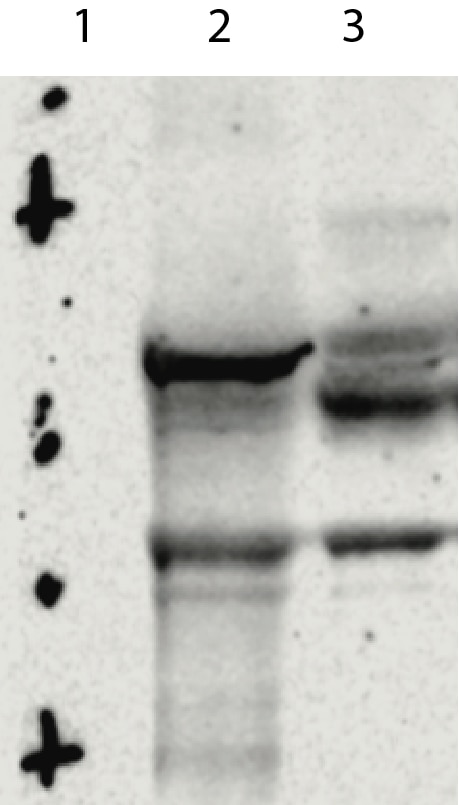Recombinant S. marcescens NucA nuclease Protein, CF Summary
Product Specifications
Met1-Asn266
Product Datasheets
Carrier Free
CF stands for Carrier Free (CF). We typically add Bovine Serum Albumin (BSA) as a carrier protein to our recombinant proteins. Adding a carrier protein enhances protein stability, increases shelf-life, and allows the recombinant protein to be stored at a more dilute concentration. The carrier free version does not contain BSA.
In general, we advise purchasing the recombinant protein with BSA for use in cell or tissue culture, or as an ELISA standard. In contrast, the carrier free protein is recommended for applications, in which the presence of BSA could interfere.
10038-NA
| Formulation | Supplied as a 0.2 μm filtered solution in Tris and NaCl. |
| Shipping | The product is shipped with dry ice or equivalent. Upon receipt, store it immediately at the temperature recommended below. |
| Stability & Storage: | Use a manual defrost freezer and avoid repeated freeze-thaw cycles.
|
Assay Procedure
- Assay Buffer: 100 mM Tris, 1 mM MgCl2, pH 8.5
- rS.marcescens NucA (Catalog # 10038-NA)
- Deoxyribonucleic acid (DNA) sodium salt from salmon testes (Millipore Sigma, Catalog # D1626), 5 mg/mL stock in deionized water
- Coupling Enzyme: Recombinant Mouse Alkaline Phosphatase/ALPL (rmALPL) (Catalog # 2910-AP)
- Malachite Green Phosphate Detection Kit (Catalog # DY996)
- 96-well Clear Plate (Catalog # DY990)
- Plate Reader (Model: SpectraMax Plus by Molecular Devices) or equivalent
- Dilute 1 M Phosphate Standard by adding 10 µL of the 1 M Phosphate Standard to 990 µL of Assay Buffer for a 10 mM stock. Continue by adding 10 µL of the 10 mM Phosphate stock to 990 µL of Assay Buffer for a 100 µM stock. This is the first point of the standard curve.
- Complete the standard curve by performing six one-half serial dilutions of the 100 µM Phosphate stock in Assay Buffer. The standard curve has a range of 0.078 to 5 nmol per well.
- Prepare a reaction mixture containing 0.16 mg/mL DNA and 4 µg/mL rmALPL in Assay Buffer.
- Dilute rS. marcescens NucA to 4 ng/mL in Assay Buffer.
- Load 50 µL of each dilution of the standard curve into a plate. Include a curve blank containing 50 μL of Assay Buffer.
- Load 25 µL of 4 ng/mL rS. marcescens NucA into empty wells of the same plate as the curve. Include a Control containing 25 µL of Assay Buffer.
- Add 25 µL of reaction mixture to the wells, excluding the standard curve.
- Seal plate and incubate at room temperature for 20 minutes.
- Add 30 µL of the Malachite Green Reagent A to all wells. Mix briefly.
- Add 100 µL of deionized water to all wells. Mix briefly.
- Add 30 µL of the Malachite Green Reagent B to all wells. Mix and incubate for 20 minutes at room temperature.
- Read plate at 620 nm (absorbance) in endpoint mode.
- Calculate specific activity:
Specific Activity (pmol/min/µg) = | Phosphate released* (nmol) x (1000 pmol/nmol) |
| Incubation time (min) x amount of enzyme (µg) |
*Derived from the phosphate standard curve using linear or 4-parameter fitting and adjusted for Control.
Per Reaction:- rS. marcescens NucA: 0.1 ng (0.0001 µg)
- rmALPL: 0.1 µg
- DNA: 4 µg
Scientific Data
 View Larger
View Larger
2 μg plasmid DNA was incubated with increasing amounts (ng/mL) of RecombinantS. marcescensNucA nuclease (Catalog # 10038-NA) in 50 mM Tris (pH 8.0) and 1 mM MgCl2 for 30 minutes at room temperature. Samples were analyzed by agarose gel electrophoresis and DNA was visualized by ethidium bromide staining.
Reconstitution Calculator
Background: NucA nuclease
Serratia marcescens endonuclease, is a non-specific nuclease that degrades both single- and double-stranded nucleic acids, including DNA and RNA, but exhibits no proteolytic activity (1); therefore, it is ideal for the removal of nucleic acid contaminants from protein samples and applications where complete digestion of nucleic acids is desirable. NucA is also commonly used in bioprocessing applications to reduce viscosity of samples caused by genomic DNA. The optimum pH for enzyme activity is found to be 8.0-9.2. It hydrolyzes internal phosphodiester bonds between nucleotides in nucleic acids to produce 5'-monophosphate oligonucleotides of 3-8 bases in length (2). The active enzyme is a homodimer with two disulfide bonds in each monomer that are crucial to the enzyme activity and stability (3). The absolute activity of the recombinant enzyme is measured by a phosphatase coupled assay (4), where the 5'-phosphate of oligosaccharides generated by the enzyme is further released by non-specific alkaline phosphatase and quantitated by Malachite reagents (5).
- Benedik, MJ and Strych, U. (1998) FEMS Microbiol Lett. 165:1.
- Nestle, M, et al. (1999) J. Biol. Chem. 274:825.
- Ball, T.K. et al. (1992) Nucleic Acids Res. 20:4971.
- Wu, Z.L. et al. (2011) Glycobiology 21:727.
- Van Veldhoven, P.P. and G.P. Mannaerts (1987) Anal. Biochem. 161:45.
Product Specific Notices
Benzonase® is a registered trademark of Merck KGaA Corporation. Bio-Techne Corporation and its affiliates, and their respective products and services, are not sponsored, endorsed, or approved by Merck KGaA.FAQs
No product specific FAQs exist for this product, however you may
View all Proteins and Enzyme FAQsReviews for Recombinant S. marcescens NucA nuclease Protein, CF
Average Rating: 4.5 (Based on 2 Reviews)
Have you used Recombinant S. marcescens NucA nuclease Protein, CF?
Submit a review and receive an Amazon gift card.
$25/€18/£15/$25CAN/¥75 Yuan/¥2500 Yen for a review with an image
$10/€7/£6/$10 CAD/¥70 Yuan/¥1110 Yen for a review without an image
Filter by:
1. Ladder
2. Sample without NucA
3. Sample with NucA


